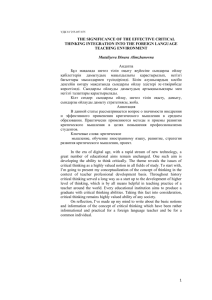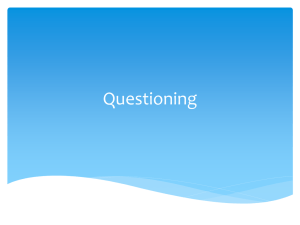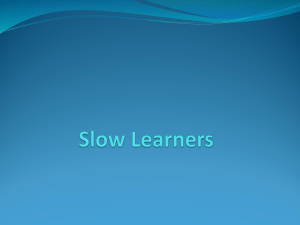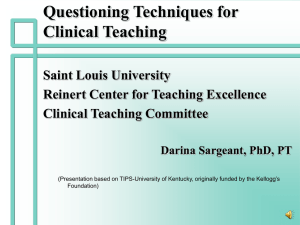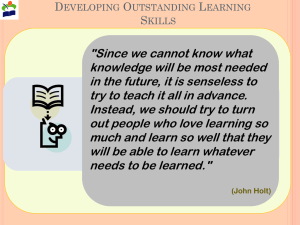Improving Learning Through Questioning FINAL with VIDEO Links
advertisement
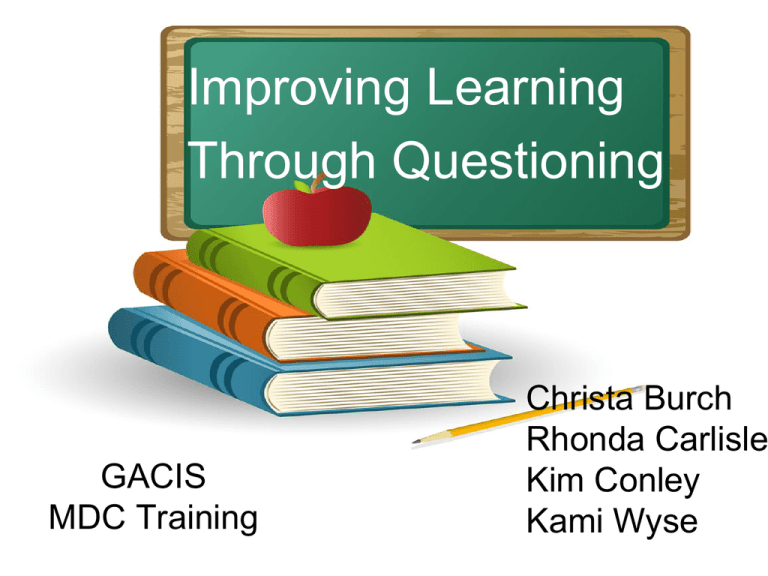
Improving Learning Through Questioning GACIS MDC Training Christa Burch Rhonda Carlisle Kim Conley Kami Wyse Classroom Questioning Research Findings • Posing questions during lessons is more effective than instruction carried out without questioning students. • Students perform better on test items previously asked during instruction • Oral questions posed during classroom instruction are more effective than written questions. • Questions which focus students on pertinent elements in the lesson result in better comprehension than questions which do not. Classroom Questioning Research Findings • • • There is a relationship between academic ability and question asking. Low-achieving students become less likely to seek help and less academically engaged over the course of their school careers. Students who feel more connected to their teachers at a personal level are more likely to ask questions. Building Rapport with Students Relationships Matter! Should you disclose basic facts about yourself? Yes, your students are curious about you. Sharing some basic information about yourself can go a long way to set your students at ease and make you more approachable. Why is tone important? • Your attitude toward your students matter! They are perceptive. • Each interaction you have with a student is an opportunity to build a relationship. • Make sure every conversation sets a positive tone. You can build rapport with your students by having clear expectations for your students so that they know how to be successful in your class. Don’t forget… • You are a role model and mentor for your students. • Building rapport does not mean you are their friend. • You should create meaningful relationships that foster an environment where students feel comfortable taking risks and are willing to learn. Create a classroom culture that is open to dialogue. Collaborative Pairs • Organization tool for a classroom where two students are grouped together for the purpose of actively engaging their thinking about the new learning. • Used extensively in FALs Creating Collaborative Pairs Alternate method for creating pairs when not using pre-assessment data Grouping Methods Alternate method for creating pairs/groups when not using preassessment data • Peas(1) /Pairs(2) /Pods(3-4) – Practice getting into groups • Random ways to group – Color sticks – Numbering – Review cards/matching (matching vocabulary word with definition or matching problem with answer) While Students Work • Circulate around the room • Listen carefully and value diversity in thinking • Provide additional direction to those in need using focused questioning, if possible • Manage conflict constructively (Balance learning & working effectively) Teaching Students to Think by Teaching Teachers to Question Why Ask Questions? • Encourage learners to talk constructively and on-task • Signal an interest in hearing what learners feel and think • Stimulate interest and awaken curiosity • Encourage a problem-solving approach to thinking and learning Why Ask Questions? • Help learners externalize and verbalize knowledge learning • Encourage thinking aloud and exploratory approaches to tasks • Help learners learn from each other • Monitor learning • Deepen learners’ thinking level and increase their ability to conceptualize Types of Questions Data Recall • Requires the learner to remember facts, information without putting the information to use. Naming Question • Asks the learner simply to name an event or process without showing insight into how the event is linked to other factors. Observation Question • Asks learners to describe what they see without attempting to explain it. Control Question Involves the use of questions to modify learners’ behavior rather than their learning. Types of Questions Hypothesis Question • Asks learners to speculate about the outcome of a hypothetical situation. Analysis Question • Ask learners to give reason(s) why certain things do or do not happen. Evaluation Question • Is one that makes a learner weigh out the pros and cons of a situation or argument. Problem Solving Question • Asks learners to construct ways of finding out answers to questions. Bloom’s Taxonomy • • • • • • Knowledge Comprehension Application Analysis Synthesis Evaluation Higher Level Questioning • Allows students to think more critically and not just repeat information • Encourages students to see themselves as producers of knowledge • Cause students to find connects to their own background knowledge and experiences • Video: How To Question Effective Classroom Questioning Develop good habits that will impact the teaching and learning process by using… • • • • • • • • • • • Direct and Simple Language Definite and Clear Meaning Logical Sequence Questions Keyed to Class Ability Stimulate Effort Create Student Interest Variety of Questions Avoid Repetition Avoid Trick Questions Avoid Yes/No Questions Appropriate Wait Time Questioning Procedure • • • • • Ask the Question Pause Call on Learner by Name Listen to the Answer Emphasize the Correct Answer ask probing questions to clarify answers, support a point, or extend their thinking Wait Time Patterns Teacher Question Wait Time 1 Student Answer Wait Time 2 Talk by students P A U S E Teacher Reaction Students respond Wait Time 1 The length of time a teacher waits after asking a question before naming a student to respond Wait Time 2 The length of time a teacher waits after a student stops talking in response to a question before giving feedback or calling on another student Research Patterns When teachers increase Wait Time 1 and Wait Time 2 to three seconds or more, there are pronounced improvements in student use of language and logic and in teacher and student expectations. Increasing wait time… • Improves student achievement • Improves student retention • Increases the number of higher cognitive responses • Increases the length and number of responses • Decreases in students’ failure to respond • Decreases student interruptions • Increases in the number of questions posed by the students WIN… I am Wondering I am Interested in I am Noticing Tell me… • • • • • • How did you arrive at that answer? Can you describe the process you used? What do you know about the problem? What do you need to figure out? What materials might help you figure this out? Are there other parts of the problem you can do first? • How does this relate to…? • What would happen if…? Closure questions… • What was something you learned from this problem/activity? • What were the mathematical concepts ? • What do you still have questions about? • What did you do to contribute to your group’s work? “Give a student a question to answer and she will learn the passage she has just read. Teach her how to ask questions, and she will learn how to learn for the rest of her life.”—James R. Gavelek & Taffy E. Raphael (1985, p. 103) References Cotton, Kathleen. (1998). Classroom Questioning. Retrieved from http://www.learner.org/workshops/socialstudies/pdf/session6/6.Classro omQuestioning.pdf Posamentier, A. and Stepelman, J. (1990). Teaching Secondary School Mathematics (3rd ed.) Sattes,B. & Walsh, J., (2005). Quality questioning research-based practice to engage every learner. Shell Center for Mathematical Education and Mathematics Assessment Project (MAP) www.map.mathshell.org Sutton, J.S. & Krueger, A. (2002). EDThoughts: What we know about mathematics teaching and learning.


